
The CF-105 Arrow Story:
Destruction of a National Dream and a Nation's Pride

| Assignment | Background | Postscript | Chronology | References (books and websites) |
|
What
influences lead the Canadian government to cancel and then
destroy all records of the CF-105 "Arrow" program?
|
|
At
the close of World-War II (WWII) the Canadian Government was in
the need of new aircraft to protect the country. A search of
England and the United States was conducted to see if any
aircraft currently in design and development or in production
would meet the Canadian requirements. The Royal Canadian Air
Force (RCAF) could not find an aircraft to meet these Canadian
requirements. The RCAF than persuaded the government to develop
their own aircraft with the Aviation Industry that had sprung up
during the war. One of the companies looked at to complete this
task was A.V. Roe Canada (Avro). Avro already experienced with
designing Jet aircraft and currently had a letter of intent from
Trans-Canada Airlines (TCA, now Air Canada) to purchase a
commercial Jetliner. Avro received an experimental contract to
design a new all-weather, night fighter aircraft (XC-100) for the
RCAF because of this experience. During the summer of 1949, Avro
first flew the C-102 Jetliner only thirteen days after the
English Comet flew, the first Jetliner to fly.
C-102 Jetliner in flight |
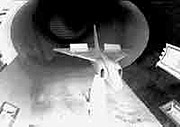 CF-105 model in wind tunnel |
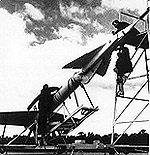 CF-105 model mounted on Nike rocket |
|
The study of the wind tunnel
testing data is complete and was available in NAE report NO. 87.
The report concluded that the proposed configuration of the
aircraft would not meet the flight radius or maneuverability
requirements due to far greater drag at super sonic speeds than
Avro's estimate. Avro responded to the Air Vise Marshall, RCAF,
that they had increased the amount of fuel on board and that wind
tunnel testing was on going. This would be the first of many
ongoing disagreements over many issues in the Arrow program
between Avro, the NAE and the DRB. On more than one occasion the
RCAF asked outside sources to review the data and make comments.
The two groups referred to the most often were the National
Advisory Committee for Aeronautics (NACA- now NASA) and the
United States Air Force (USAF). To the credit of the Avro
designers, these outside agencies came to the support of Avro's
work. So on October 4, 1957, the first CF-105 (Arrow #25201) was
rolled out of the hanger to the joys of the Avro Employees and
the support of the Canadian Government.
|
|
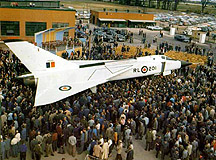 CF-105 Roll-Out Ceremony |
|
|
In
the election of 1957, the Conservative Party under John
Diefenbaker came to power with a minority government. The first
act of the Diefenbaker Government was to sign, a mutual defence
agreement with the Unites States. That agreement was the North
American Defence Treaty (NORAD). This was a quick turn of events
from what the prior Liberal Government had seen as a negative
deal for Canada. This agreement put the defence of North America
and Canada, into the Defence polices of the United States.
On April 18, 1958,
Arrow 201 for the second flight that day, was preparing to make a
speed run to altitude. Jan Zurakowski took off and headed out
over Georgian Bay to start the run towards Peterborough and
Kingston, Ontario. As he opened up the throttles the Arrow pulled
away from the chase planes and toped out at 50,000 feet and at
Mach 1.52. It was noted that 201 was still climbing and
accelerating when Zurakowski cut the throttles to level off at
50,000 feet. Later that year Arrow 202 reached the top speed in
the flight test program so far of Mach 1.98. It should be noted
this level of performances was achieved with the interim JP-75
engines. From this point on the Arrow was restricted in speed, so
Arrow 206 with the Iroquois engines could try for the World Speed
record. This decision was made so an all Canadian aircraft could
show the world what Canada had done. Also it was hoped that if
the Arrow with the Iroquois engines held the World Speed record
that it might help in promoting the sales of the Arrow. Some
people disagreed with this decision and believed that Arrows
201-205 should have set the World Speed record with the JP-75
engines before Arrow 206 arrived. Than with Arrow 206, we could
advance the record using the Iroquois engines to show how
advanced the engine and Arrow was. Sadly, however, Arrow 25206
did not make it off the assembly line before "Black Friday." And
therefore no attempt at the World Speed record was ever taken by
an Arrow. As a result of the Liberal's loosing the 1957 election, their party leader, Louis St. Laurent, resigned. Lester B. Person, now the Liberal Party leader, was persuaded by the party cohorts to table a new motion in the House of Commons. It turned out this was an ill-conceived motion that caused much embarrassment, and allowed the minority Conservative government to make up substantial political ground. The new Liberal leader took a harsh and humiliating baptism by fire at the hands of Prime Minister Diefenbaker. The Conservatives took this stumble by the Liberals to dissolve the minority government and Parliament, and to call for an election on March 31, 1958. The Conservatives won the election with the greatest majority given any party in the House of Commons (208 out of 265 seats). This new majority gave the Diefenbaker Conservatives the ability to control the government and to push through their own agenda without opposition. As the political environment was changing, Avro pushed ahead with the flight-testing and production of the Arrow. The big day finely arrived on March 25, 1958, when Jan Zurukowski at the controls lifted Arrow 201 into the air at 9:51am. The flight lasted 35 minutes with a set of mild maneuvers to check responses and general operation of aircraft equipment. The flight was excellent with no major snags. The only snag recorded was with two micro switches that had failed to work. Arrow 201 flight-testing continued with improvements beyond everyone's expectations. Arrow 201 and sequence Arrows (25202-205) relied on the interim use of the Pratt & Whitney JP-75 engines. The first stage of the flight test program was using these engines until the Iroquois engines could be obtained from Orenda Engines. The Iroquois engines were not expected to be installed in an Arrow until #25206, completed assembly and entered the flight test program in March 1958. As the other aircraft (# 25202-205) joined the flight test program, they added to the continued advancement of the performance of the Arrow. |
|
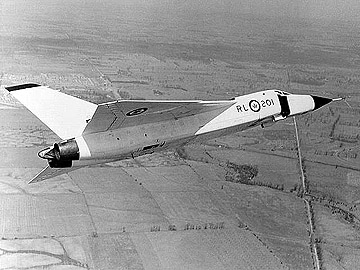 |
|
The CF-105 Arrow was not just meeting the requirements of Specifications Air 7-3 but exceeding them, as noted by officials from the RCAF and government agencies. As much as was noted about the Arrow exceeding the requirements, some at the RCAF, NAE, and DRB did not like how Avro was doing this. The Arrow and Avro drew much criticism and bad ink from this group through the press, and this helped the Government in its ability to cancel the program. At cancellation Arrows' #25201-205 had logged some 70 hours and had reached a top speed of Mach 1.98 at an altitude of 50,000 feet. With the majority in the government, Prime Minister Diefenbaker and his cabinet went about reviewing all government expenditures looking for cost cutting measures to implement their plans for new programs. Some of the new programs were nothing more than basic social justice items, whereas others had intrinsic merit. The CF-105 Arrow program was one of the programs under review in part due to the raising cost of production and the government's commitment to NORAD. Originally, under the Liberals; the Arrow program was estimate at $100 million, but that figure was a gross miscalculation, because by 1957-58 the program cost $235 million and required another $100 million in fiscal year 1958-59. October 4,1958, the day of the Arrow's roll-out, coincided to the surprise of the world with the launch of the Russian satellite Sputnik. This launch changed the thinking of Western Governments and Military Leaders alike. The current thinking was that the Russians were behind the United States in rocket technology. The launch of Sputnik confirmed that they were not, and put fear in the western governments. The continual beeping reminded them of the advancement by the Russians and caused a change in military thinking. If Russia could launch a satellite into orbit, it would be easy to replace the satellite with a nuclear warhead and return it from orbit over an enemy. Many military leaders thought that the age of manned aircraft was over and the age of missiles was here. This theory leads the Canadian Government and military leaders to believe that the Arrow would be obsolete before it went into production, and therefore should be replaced by a missile system. While the idea of replacing aircraft with missiles prevailed in Canada, the USAF and NORAD were still arguing that the Russian Bomber is still a threat and that manned aircraft were needed to oppose that threat. Another problem facing Avro and the Canadian Government was the lack of foreign sales, particularly to the United States. At the start of the program the RCAF had bought the USAF and NACA in to review some of the data and settle disagreements. In the beginning the Arrow found a great deal of support in the USAF. At one point in the development of the Arrow, the USAF offered to buy 2 squadrons for placement in and operated by Canada. After 1955 in the United States and the 1958 election in Canada, support for the Arrow started to dwindle. In 1956, the U-2 High Altitude Reconnaissance aircraft had become operational for the CIA. The CIA was using the cover of the U-2 as a weather research aircraft to over fly and to spy on other countries. Any flights by the U-2 needed approval from Allen Dulles, Head of the CIA, John Foster Dulles, U S Secretary of State, as well as the President and others. With knowledge of these two aircraft (CF-105 and U-2), John Foster Dulles in his role as the U S Secretary of State was in a position of knowing the aircraft's capabilities and any vulnerabilities. The only aircraft that John Foster Dulles knew in development that might threaten the U-2 was the CF-105. Therefore he could not let the development of the CF-105 continue, if the U-2 over flights were to continue. One of the problems in Canada after 1958 was with the new Chief of Staff for the military. General Foulkes believed that the Arrow was obsolete and wanted it replaced by a missile defence system. Another problem was the Canadian Government's commitment to NORAD. With the signing of the NORAD agreement, Prime Minister Diefenbaker had committed Canada to buying the BOMAC missiles and SAGE system. This missile defence system was intended for the defence of the Strategic Air Command (SAC) bases in the United States and not for Canada. The commitment Canada had made by signing the NORAD treaty put a strain on the defence budget. The strain on the budget was so great that projects either had to be shelved or scraped all together. On at least one occasion John Foster Dulles and others in the United States Government were told that Canada could not afford both the CF-105 and the BOMAC missiles and SAGE system. In August 1958, the US Secretary of State told the Canadian Defence Minister Pearkes, that if Canada did not accept the BOMAC missiles and SAGE system then the United States would have no choice but to place them just south of the Great Lakes. From this meeting the decision to cancel the CF-105 Arrow program was easy. No, Arrows meant, no possibility of nuclear fall out over densely populated areas in Canada. The decision was to cancel the Arrow in favor of the BOMAC missiles and SAGE system. Avro was kept in the dark about the decision, and found support of the Arrow dropping in Canada and the United States. The Diefenbaker government continued assurances to Avro that no decision on the Arrow would be made, before the review in March 1959. On February 20, 1959 "Black Friday," at 11:00 am the Prime Minister Diefenbaker rose in the House of Commons to make an announcement: "Mr. Speaker, with the leave of
the house I should like to make a somewhat lengthy statement on
the subject of one facet of the national defence of Canada
because, after all, the effectiveness, or other-wise, of the
measures taken for the national defence until international peace
under law is obtained constitutes the passport either to survival
or destruction. The announcement I wish to make has to do with
the decision regarding our air-defence, which foreshadowed in the
statement made by me to the press on September 23 last.
"The government has carefully examined and re-examined the probable need for the Arrow aircraft and Iroquois engine known as the CF-105, the development of which has been continued pending a final decision. It has made a thorough examination in the light of all the information available concerning the probable nature of the threats to the North America in the future years, the alternative means of defence against such threats, and the estimated cost thereof. The conclusion arrived at is that the development of the Arrow aircraft and Iroquois engine should be terminated now." Coinciding with this announcement a telegram was sent from the Department of Defence Productions to Avro and Orenda engines (Iroquois). The telegram informed them of the termination of contracts and ordering the company to cease work immediately. Avro, in response to this announcement with no other work to support the workforce, laid off all employees. In total 14,000 workers lost their job that day between Avro and Orenda. |
|
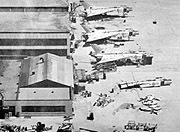 |
By about April 1959, government officials had moved into Avro's plant in Malton, Ontario and started to destroy all documents, tooling, and aircraft associated with the CF-105 program. The aircraft were cut up and hauled away as scrap. No part of the CF-105 Arrow program was to be saved. | 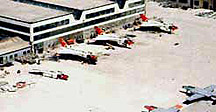 |
|
One year after the cancellation of the Arrow, NORAD insisted that Canada consider a replacement for the CF-100. The replacement aircraft was an aircraft looked at and rejected in 1953 as not meeting the Specifications AIR 7-3 . Canada did not buy new aircraft but in a swap received some used Air National Guard F101 Voodoo's from the United States. In addition the only pieces of the CF-105 Arrow to escape the cutting torch was a main landing gear and cockpit section from Arrow 206, a sad not to Canadian aviation history. The cancellation of the Arrow also brought about a lost of Canadian pride. We had in short time put together a world-class aviation industry and designed in the process some of the world's best aircraft. If the Arrow had continued into production, it would have placed Canada in a position to be a world leader in the Aviation industry. With the cancellation of the Arrow and Iroquois engine program, the Canadian Government sent some of the best engineers in the aviation industry looking for employment outside of the country. Some of the Avro engineers found jobs in England working on the Concord. Many others went to the United States to work with some of the Aviation Giants like Lockheed, Boeing, And Grumman to name a few. Others went to NASA and helped meet now President Kennedy's goal of putting a man on the moon. 1947 - Air Marshal W. A. Curtis named
Chief of the Air Staff: Modernization program launched: CF-100
development begins.
1949 - August - First flight of the Avro Jetliner (C-102) 1950 - Korean War starts: Canadian Government stops production of Jetliner in favor of speeding up production of CF-100. 1951 - RCAF begins planning for a successor to the CF-100 - October - RCAF receives delivery of the first CF-100 1952 - RCAF team delivers Final Report on the All-Weather Interceptor requirements. 1953 - St. Laurent government makes decision to proceed with development, initial appropriation $30,000,000 - October - Hawker Sidney Design Council approves design of the P.S. 13 Iroquois. 1954-Orenda authorized by its parent company to proceed with the design and manufacture of three engines. -Preliminary wind tunnel work completed and first production drawings passed to manufacturing. RCAF elects to develop new weapons system, "ASTRA" and new missile "Sparrow II" - The Iroquois run on its own power for the first time. 1955 - Canadian government places a contract for remaining development of the Iroquois. 1956 - Preliminary flight rating test run on the Iroquois: United States U-2 aircraft becomes operational for the CIA. 1957 - April - Iroquois test run at 18,000 pounds and later the same year at 20,000 pounds dry thrust. - June - Diefenbaker's Conservatives elected as a minority government. - July - John Foster Dulles visits the new Canadian Government of Prime Minister Diefenbaker for talks, which quickly result in the formation of NORAD. - October- Roll out ceremony of the Arrow at Malton: Russians launch Sputnik I at Baikonur 1958 - March - First flight of the Arrow: Prime Minister returned to office in landslide - April - High Speed run of the Arrow, Mach 1.52 at 50,000 feet. - June - Malfunction of the landing gear and damage on landing to Arrow 201 - August - Arrow # 25202 join the flight test program. - September - Negative press release issued by Prime Minister Diefenbaker on the Arrow: Arrow #25203 join the flight test program - October - Arrow #25204 join the flight test program - November - Arrow 202 reaches top speed in test program of mach 1.98 and suffers a landing accident. 1959 - January - Arrow #25205 join the flight test program: flown only once for 40 minutes. - February -Prime Minister Diefenbaker announces cancellation of Arrow And Iroquois: Last flight in the program was February 19 in Arrow 201 at Mach 1.75 for 50 minutes - April - The Arrow cut into scrap. I first became interested in the story of the Avro Arrow as a young man living in Canada and helping out with the Royal Canadian Air Cadets . My understanding of the story was to blame the Diefenbaker Government for the destruction of this aircraft. For a number of years I have held to the belief, that it was the Canadian Government under the Leadership of Mr. Diefenbaker and his Conservatives' agenda for cutting back on government spending by the previous governments. Since I started my research into the Arrow for this web page, I have come to understand many different things about the Arrow and why it was canceled by the Canadian Government on February 20, 1959. The first book I ever owned on the subject was "Arrow" Revised Edition by The Arrowheads (Boston Press, 2000). This book I found to be a good starting point in the research. With the start of this web page I have come across some other books that have helped expand my understanding of the issues. To help understand how advanced the Arrow was for the time and a great deal on Avro Aircraft Canada try "Avro Aircraft & Cold War Aviation" by Randall L. Whitcomb (Vanwell Publishing LTD, 2002). Any time you involve the government in a story, you need to understand the political environment of the times. There are two book I found useful. the first was "Storms of Controversy Third Edition: by Palmiro Campagna (Stoddart Publishing Co. Limited, 1998) This held a lot of information on Top Secret files, that until now was not available to the public. The other book was "Fall of an Arrow" by Murray Peden (Stoddart Publishing Co. limited, 2001), this book talks about the pressures brought about on the Canadian Government at this time 1959. Another book that is worth reading if you can get a copy is "Shutting Down the National Dream" by Greig Stewart (McGraw-Hill Ryerson Ltd., 1988 [hard to find, might be out of print]) I was unfortunately not able to get a copy to help out with this research. Many books and web sites have been consulted in preparation of this web page. Some of the information has been quoted from these original sources and others. Some General Aviation books I have found: Chronicle of Aviation: conceived and published by Jacques Legrand (JL International Publishing Inc. ,1992) Jane's Aircraft Recognition Guide (Harper Collins, 1999) May-Day by Michael R. Beschloss (Harper & Row, Publishers, Inc. 1986) The Complete Book of Top Guns (Publications International, Ltd. 1990) The Great Book of Fighter Planes (Publications International, Ltd. 1990) Skunk Works by Ben R. Rich (Little Brown, 1994) The Leading Edge Updated Edition by Walter J. Boyne (by arrangement with Stewart, Tobori & Chang Inc. Artabras edition, 1991). Here is the list of websites that I found very useful for researching the Arrow on-line:
|
This page is copyright © 2010, C.T. Evans and C.
Moore.
For information contact cevans@nvcc.edu